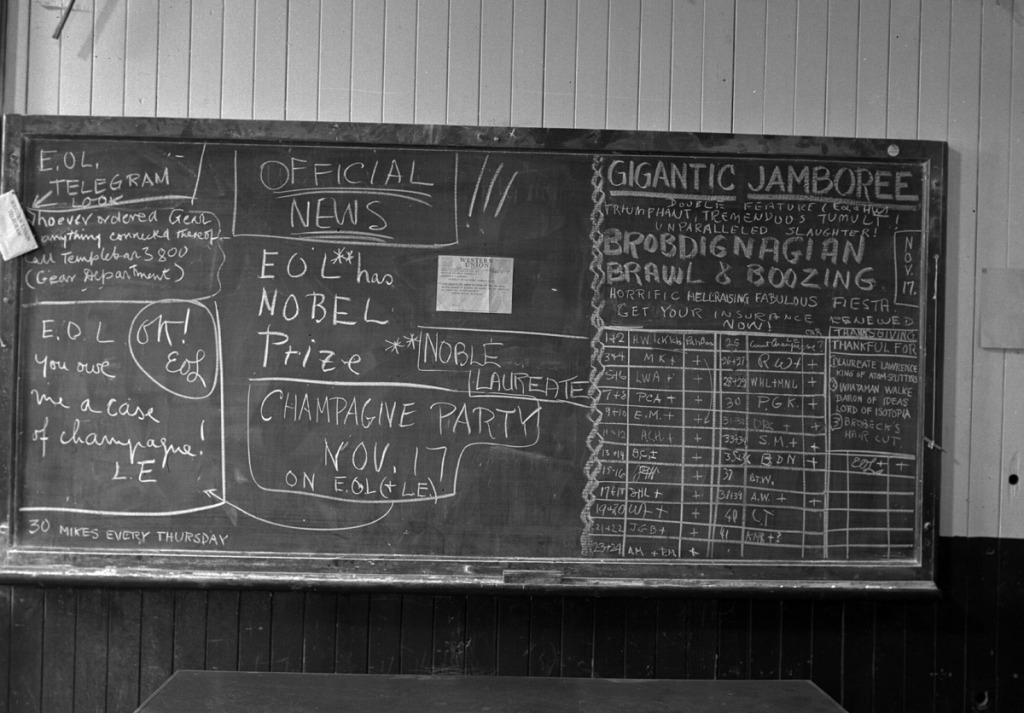The Rad Lab – From A Small Wooden Building to a National Laboratory
By Lynn Yarris
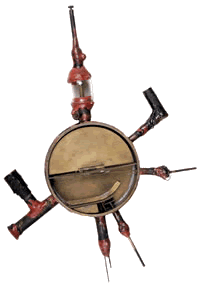
The first cyclotron.
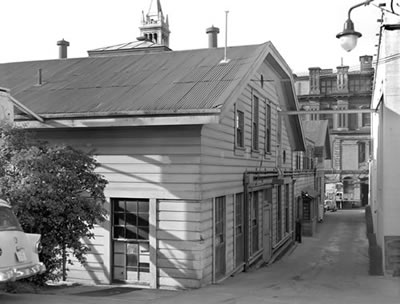
The old radiation Laboratory on the UC Campus.
Historians cite the Roaring Twenties as the decade in which the United States began its transition into a modern technology-based society. For the first time in the nation’s history, a majority of its citizens lived in urban areas. The Golden Age of radio broadcasting began; automobiles, telephones, and electric appliances became staples. The stock market soared and crashed. Prohibition came and went. Suffrage came and stayed. Politicians gave us isolationism, preachers gave us revivalism, and bootleggers brought us organized crime.
It was a period of momentous individual achievement and the emergence of new leaders who forever changed the way things had been done. Charles Lindbergh’s solo flight across the Atlantic ushered in the age of modern aviation; Babe Ruth’s home run heroics made baseball the national pastime; and Henry Ford’s assembly lines opened the doors to mass production. In the arts, the literature of Scott Fitzgerald and Ernest Hemingway, the music of George Gershwin, the humor of Charlie Chaplin, and the paintings of Edward Hopper showed the way with their enduring brilliance. And in the arcane world of science, a 27-year-old physics professor in Berkeley began the work that would launch the modern era of multidisciplinary national laboratories. His name was Ernest Orlando Lawrence.
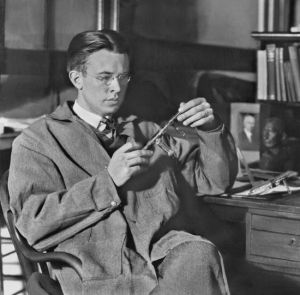 Ernest Lawrence arrived at the University of California’s Berkeley campus in the summer of 1928, having been wooed from a faculty position with Yale University by promises that included auxiliary connections to the chemistry department. Until then, the traditional practice of science was that physicists, chemists, and biologists worked within their own departments and seldom ventured outside their disciplines. Access to scientists and students from other disciplines, as well as to engineering staff, was critical to Lawrence’s success as a researcher. It also set the pattern for the unique laboratory he created.
Ernest Lawrence arrived at the University of California’s Berkeley campus in the summer of 1928, having been wooed from a faculty position with Yale University by promises that included auxiliary connections to the chemistry department. Until then, the traditional practice of science was that physicists, chemists, and biologists worked within their own departments and seldom ventured outside their disciplines. Access to scientists and students from other disciplines, as well as to engineering staff, was critical to Lawrence’s success as a researcher. It also set the pattern for the unique laboratory he created.
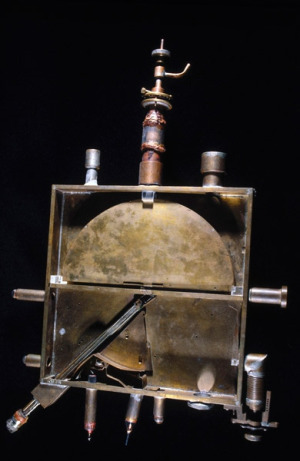
The 11-inch cyclotron, the first machine to break the one million electron volt (MeV) barrier. Read the story of this historic cyclotron’s return to Berkeley Lab.
Inspired by a paper from Norwegian engineer Rolf Wideroe, Lawrence, early in 1929, drew up plans for a unique circular particle accelerator, which he referred to as his “proton merry-go-round,” but which would later become known as the cyclotron. It would be another year before Lawrence’s invention was actually made into a device. The first crude cyclotron was constructed in the spring of 1930 by Lawrence and his student, Nels Edlefsen. It was a pie-shaped concoction of glass, sealing wax and bronze. A kitchen chair and a wire-coiled clothes tree were also enlisted to make the device work. Despite its Rube Goldberg appearance, the cyclotron proved Lawrence’s point: whirling particles around to boost their energies, then casting them toward a target like stones from a slingshot could be an efficient and effective way to smash open atomic nuclei.
The first working model of a cyclotron came later that fall with the help of another Lawrence student, M. Stanley Livingston. The accelerating chamber of this cyclotron measured 5 inches in diameter and on January 2, 1931, it was successfully used to boost hydrogen ions (protons) to an energy of 80,000 electron volts. Immediately, Lawrence instructed Livingston and another student, David Sloan, to begin construction on an 11-inch cyclotron, a machine that would go on to break the one million electron volt (MeV) barrier. However, even as Livingston and Sloan were starting this project, Lawrence was dreaming of bigger things.
In his first year at Berkeley, Lawrence had developed close relationships with two UC Berkeley professors outside of the physics department, chemist Gilbert Lewis and electrical engineer Leonard Fuller. From Lewis he would later get deuterons, the hydrogen isotope in heavy water that proved an invaluable “stone” for smashing atoms. Fuller, who was also vice-president of the Federal Telegraph Company, helped Lawrence obtain an 80-ton magnet that had originally been built to power a transatlantic radio link in World War I but was now surplus. With the gift from Federal Telegraph, and deuterons to use as projectiles, the construction of a cyclotron with an accelerating chamber 27 inches in diameter, capable of reaching energies of nearly 5 MeV, had been made possible. Lawrence, however, would need more laboratory space, one with an exceptionally firm floor.
UC Berkeley had opened Le Conte Hall in 1924 as one of the largest physics buildings in the world. The goal was to build a physics department equal in stature to the University’s celebrated chemistry department. As part of that build-up, Lawrence had been lured away from Yale University and brought to Berkeley in 1928. One of the principals behind Lawrence’s recruitment was Robert Gordon Sproul, secretary to the UC Board of Regents and protégé of master university builder Benjamin Ide Wheeler. Sproul was betting that Lawrence would become one of the nation’s top physicists. He showed his faith in the fall of 1930 when, one day before his formal inauguration as the 11th UC president, he signed off on Lawrence, then 29, becoming the youngest man ever to be named a full professor on the Berkeley faculty.
Lawrence had been working out of Room 329 in Le Conte Hall, which was large enough to accommodate the 11-inch cyclotron, but not the 27-inch cyclotron, with its 80-ton magnet. After being refused space by the engineering faculty in the Mining Building, Lawrence turned to the new UC President and, once again, Sproul came through. On August 26, 1931, he committed to Lawrence the Civil Engineering Testing Laboratory, an empty building adjacent to Le Conte Hall which featured substantial concrete flooring, strong enough to support an 80-ton magnet. Lawrence renamed this building the “Radiation Laboratory,” but, in short time, it became known as simply as “the Rad Lab.”
Lawrence’s Boys
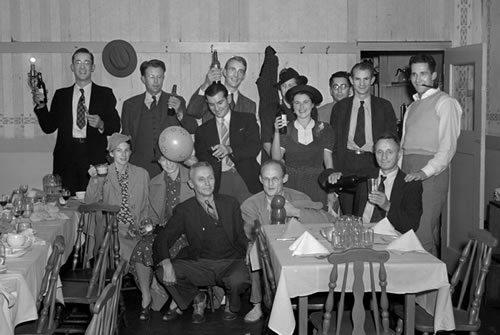
Rad Lab camaraderie found a social outlet at Di Biasi’s restaurant in Albany. Back row, left to right, standing: Bob Cornog, Ernest Lawrence, Luis Alvarez, Molly Lawrence, Emilio Segre; second row: Jerry Alvarez (seated), Betty Thornton, Paul Aebersold (standing), Iva Dee Hiatt, Edwin McMillan, Bill Farley; first row: Donald Cooksey, Robert Thornton, and one unidentified celebrant.
The 1930s will forever be remembered in this country for the Great Depression, when the land of opportunity became the land of despair. Between 1930 and 1932, nearly half of the nation’s banks failed, Hooverville shanties sprang up across the land to shelter the thousands who’d lost their homes, and the farmlands of the Great Plains were transformed into a “Dust Bowl.” The election of Franklin Roosevelt as president in 1932, with his New Deal programs and Fireside Chats, began turning things around, but the climb back to prosperity would be difficult. Despite the adversity, there were notable triumphs. Two African American athletes, boxer Joe Louis and track star Jesse Owens, lifted the nation’s spirits with their transcendent skills. Will Rogers and Walter Winchell reached millions of radio listeners, the movie Gone with the Wind smashed box office records, the Empire State Building and Mount Rushmore were completed, Richard Byrd explored Antarctica, Frances Perkins became the first woman to serve on a President’s cabinet, and out on the West Coast, the boyish-looking director of UC Berkeley’s Rad Lab assembled a team of scientists and engineers whose accomplishments would become legendary.
It took a year to get the 27-inch cyclotron up and running in the Rad Lab, but by September 1932 the machine was accelerating protons to 3.6 million electron volts. The centerpiece of the new Rad Lab would not enjoy its celebrity for long. Lawrence, always eager to advance to the next level, and somehow able to obtain funding despite the scarcity of money, laid plans to expand its accelerating chamber and make other modifications that resulted in a new 37-inch cyclotron, which, by 1937, could accelerate deut-erons to 8 MeV and alpha particles to 16 MeV. This machine was used to create radio-isotopes and the first artificial element, technetium.
The design, construction, and operation of increasingly larger cyclotrons required an increasingly larger number of physicists, engineers, and chemists. Lawrence’s personal charisma, unbridled enthusiasm and almost uncanny ability to procure financial donations from private sources, enabled him to recruit the best and the brightest. During the decade, the Rad Lab staff grew from five to 60 members. These members included Edwin McMillan, Luis Alvarez, Glenn Seaborg and Emilio Segrè, all of whom would go on to be Nobel laureates, plus other notables, such as Martin Kamen, J.J. Livingood, Philip Abelson, Felix Bloch and the peerless instrument maker Donald Cooksey. One of the most valuable of all his recruits came from Hollywood, mechanical engineer William Brobeck.
Lawrence’s scientific recruits proudly called themselves “Lawrence’s boys,” and they were evenly divided between physicists and chemists. Throughout the early years of the Rad Lab, Lawrence was never quite certain as to whether the research there should be called nuclear physics or nuclear chemistry. In recognition of this departure from the traditional academic lines of departmental science, the University on July 1, 1936 officially established the Radiation Laboratory as an independent entity within the Physics Department. Henceforth, the new laboratory would be dedicated to pursuits of “nuclear science” rather than physics or chemistry.
Lawrence, however, was not content to limit Rad Lab research to just two major disciplines. In 1935, he invited his brother John, a physician, to join the Lab and explore the use of cyclotron-produced radioisotopes in biology and medical research. Other physicians, like Joseph Hamilton and Paul Aebersold, soon followed.
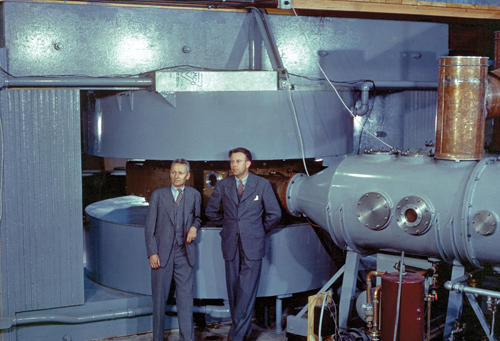
Donald Cooksey and Ernest Lawrence at the 60-inch cyclotron in the Crocker Laboratory.
The addition of physicians and biologists into the Rad Lab’s scientific mix led to the construction of a second building adjacent to the Rad Lab. Named the Crocker Radiation Laboratory after UC Regent William Crocker who donated the money for its construction, this new facility was designed to house a cyclotron with an accelerating chamber that measured 60 inches in diameter and a magnet that weighed 220 tons. The use of this machine by John Lawrence and his fellow physicians gave rise to modern nuclear medicine.
The 60-inch cyclotron began operations in 1939, the year that UC President Sproul’s gamble on Lawrence was fully realized. For his invention of the cyclotron, Lawrence won the 1939 Nobel Prize in Physics. The end of the decade would mark the end of the era of new Lawrence cyclotrons on the UC Berkeley campus. For the next machine he envisioned, a giant more than double the size of the 60-inch cyclotron, Lawrence would have to relocate his laboratory.
